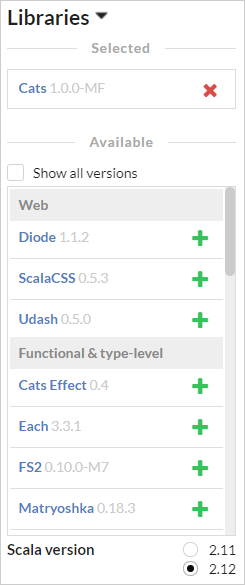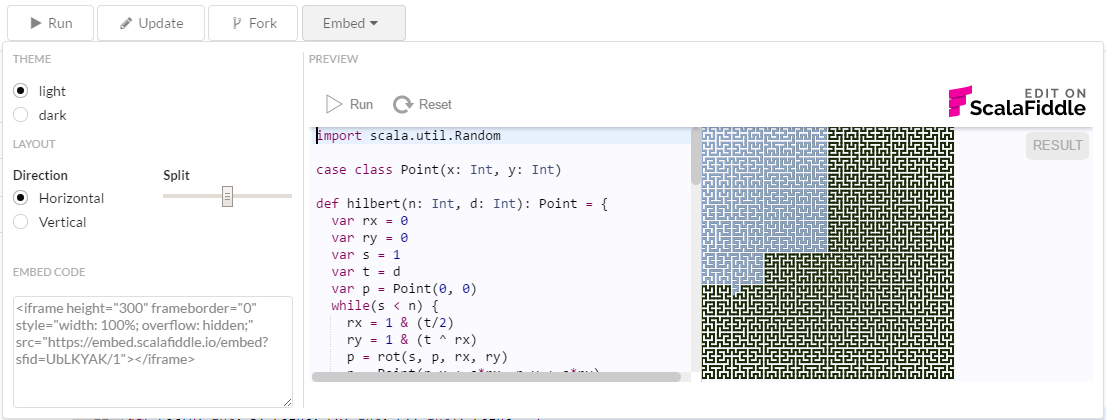Welcome to ScalaFiddle
ScalaFiddle is an online playground for creating, sharing and embedding Scala fiddles (little Scala programs that run directly in your browser).
Quick start
Just write some Scala code in the editor on the left and click the Run button (or press Ctrl-Enter on Windows/Linux, or
Cmd-Enter on macos) to compile and run your code. The result will be shown
here, replacing this documentation. You can
always get this page back by clicking the Help button.
A truly simple example to get you started:
println("Hello world!")
Saving your masterpiece
To make the fruit of your labors immortal, click the Save button. This will assign a random
identifier to your fiddle and
update the page URL to something like https://scalafiddle.io/sf/S0mXhH9/0.
The last part of the URL is a version number,
which is incremented every time you updated the fiddle. This means that once a fiddle is saved, it cannot be
modified, but a
new version can be created.
By default, all fiddles are anonymous, but if you want to keep them under your own control, you should create an account via Sign in with GitHub. This way no one else but you can update the saved fiddle. Others can only Fork it to continue work under their own account.
To make sure you can later find your fiddle, remember to add a Name and Description to your fiddle before saving.
Using libraries
You can experiment with different supported Scala libraries by selecting them from the Libraries section on the left sidebar. Just press the + button to add a library to your fiddle, and X to remove it. The latest version is shown by default, but you can also Show all versions if you need to work with an older one.

By default new fiddles use Scala 2.12, but you can also select another Scala version.
Editing code
Although the editor in ScalaFiddle is no match for a full IDE, it’s quite adequate for small fiddles. It provides
rudimentary
syntax highlighting and things like search (Ctrl/Cmd-F). You can
also access code completion by pressing Ctrl/Cmd-Space
to get a list of potential completions suitable for that location. Note that this feature actually calls the
remote compiler
to perform the code completion, so there might be a slight delay.
Your fiddle code is actually contained in a template, which you can show by clicking the SCALA button in the top-right corner of the editor.

This template makes sure your code is contained in a single object that is exposed to JavaScript so that it can be executed. Normally you don’t need to deal with the template, but sometimes you need to take things outside this object and then it’s necessary to edit the code on the outside.
Special features
Because ScalaFiddle runs in the browser, you can access browser features like the DOM and Canvas in your fiddle.
There is a
helper object called Fiddle that contains methods for accessing the DOM
and the built-in canvas.
Using the DOM
The simplest way for using the DOM is to generate your DOM elements using the included Scalatags
library. For this you
need to import scalatags.JsDom.all._ and use Fiddle.print to show the DOM, as in the example below.
import scalatags.JsDom.all._
val h = h1("Hello world").render
Fiddle.print(h)
You can also make the DOM interactive as demonstrated by the simple fiddle below:
import scalatags.JsDom.all._
val textInput = input(placeholder := "write text here").render
val lengthButton = button("Length").render
val result = p.render
lengthButton.onclick = (e: Any) => result.innerHTML = textInput.value.length.toString
Fiddle.print(div(textInput, lengthButton), result)
Drawing to canvas
ScalaFiddle automatically provides a rectangular canvas in the output panel that you can use for drawing. The
canvas drawing
context is accessible via Fiddle.draw and represents a
CanvasRenderingContext2D
To draw a small 50 by 50 pixel rectangle at position 10,10:
Fiddle.draw.rect(10, 10, 50, 50)
Fiddle.draw.stroke
For a more complex example, check out the Hilbert curve demonstration
Embedding
While editing and sharing fiddles on scalafiddle.io website is great, you can also embed your fiddles to any web page you like. The embedded fiddle provides interactive editing, so you could for example include a short example on your documentation site or in your blog and have viewers play with it right there, on your own page.
To create an embedded fiddle, just click the Embed button, which will present you with some options, the HTML code you need to copy paste, and a preview of what the embedded fiddle will look like.

Embedding instructive fiddles to your library documentation is a great way to let your library users try out features without installing anything.
Integration to documentation
ScalaFiddle can also be integrated directly into documentation without embedding from the editor. See the section on ScalaFiddle integration for more information.
Source
ScalaFiddle is open source and you can find all the source code in GitHub repositories.